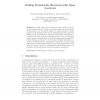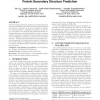1746 search results - page 57 / 350 » On Compressibility of Protein Sequences |
ICASSP
2007
IEEE
14 years 2 months ago
2007
IEEE
Protein structure prediction aims to determine the three-dimensional structure of proteins form their amino acid sequences. When a protein does not have similarity (homology) to a...
ISMB
1998
13 years 9 months ago
1998
A novel method to model and predict the location and orientation of alpha helices in membrane- spanning proteins is presented. It is based on a hidden Markov model (HMM) with an a...
BIBE
2009
IEEE
14 years 2 months ago
2009
IEEE
— Protein sequence motifs information is crucial to the analysis of biologically significant regions. The conserved regions have the potential to determine the role of the protei...
ECAL
2007
Springer
14 years 1 months ago
2007
Springer
Abstract. Proteins, under native conditions, fold to specific 3D structures according to their 1D amino acid sequence, which in turn is defined by the genetic code. The specific...
SIGIR
2004
ACM
14 years 1 months ago
2004
ACM
Protein secondary structure prediction is an important step towards understanding the relation between protein sequence and structure. However, most current prediction methods use...


